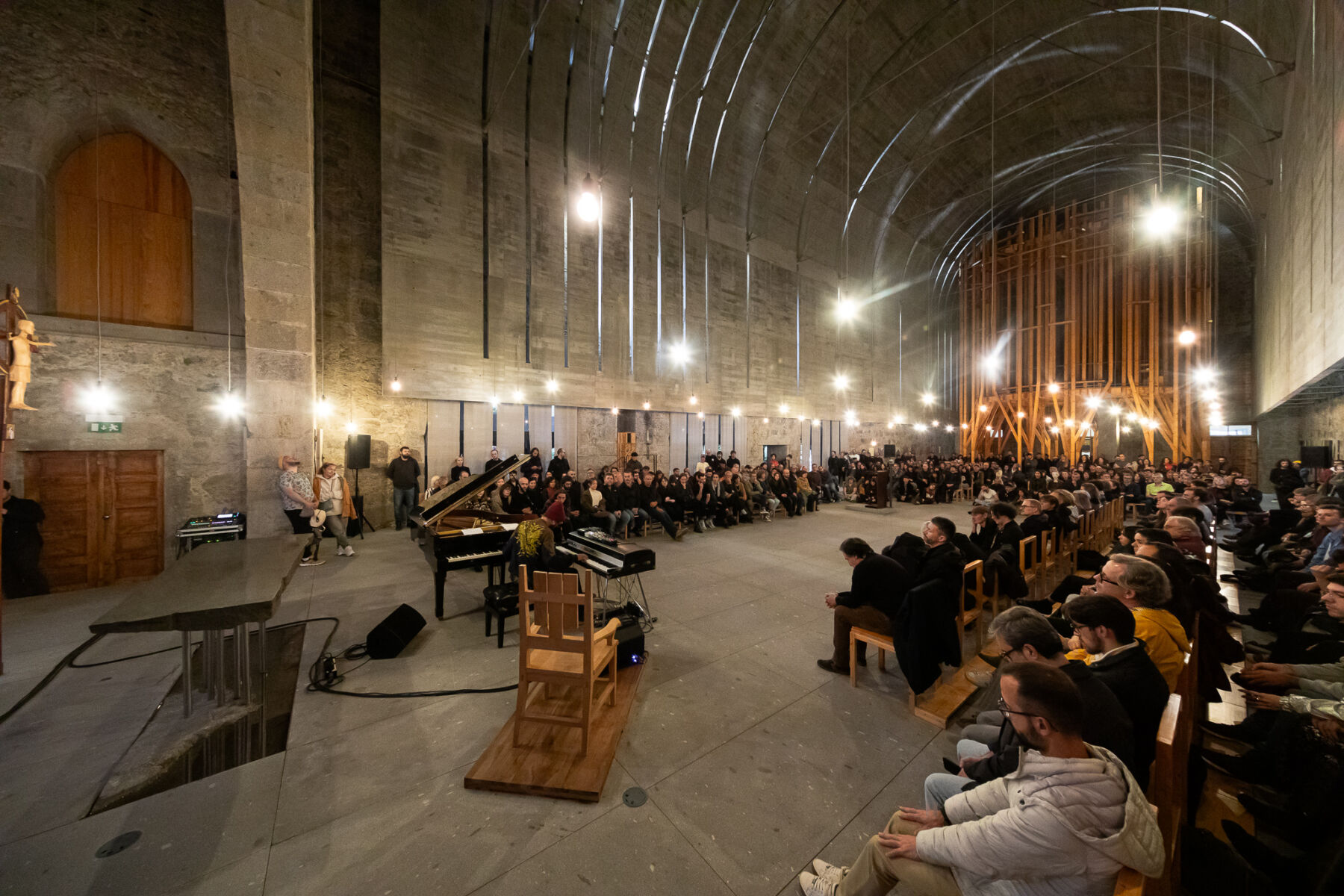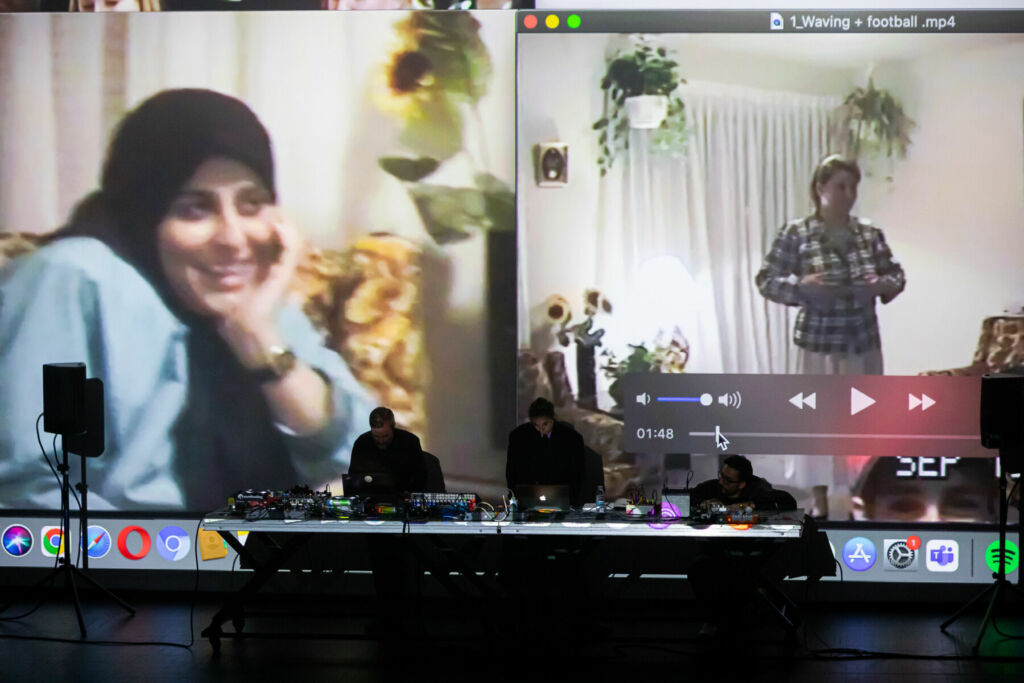Text by Irem Erkin

Braga, a city that fuses contemporary vibrancy with deep historical roots, serves as the perfect backdrop for the Semibreve Festival. Walking through its streets, you feel the layers of tradition alongside the pulse of something new and exciting. It’s a fitting setting for Semibreve, a festival that celebrates cutting-edge electronic music and digital art while honouring the city’s rich heritage. The festival feels perfectly at home here, drawing you into an atmosphere where the past and future beautifully coexist.
Semibreve, held annually in Braga since 2011, is not just any festival; it’s a truly special experience. Since its launch, it has been at the forefront of electronic music and digital art, consistently presenting a forward-thinking programme. Featuring some of the world’s most esteemed electronic artists, the festival curates a vibrant and diverse mix of genres and artistic expressions.
However, what truly sets Semibreve apart is the genuine love, passion, and care poured into every aspect of the event. From the meticulous selection of the programme to the breathtaking venues, attention to detail is evident at every step. The festival’s dedication to the artists is equally impressive, as it goes beyond simply showcasing talent. There is a sense of warmth and authenticity in the way they connect with both performers and attendees, ensuring that everyone involved feels welcome and valued.
The festival is known for its carefully considered lineup that balances accessibility with challenge. It’s a programme that invites you to think while still being open to all. What’s even more impressive is how the festival uses the city’s incredible venues to enhance the experience. You have places like Teatro Circo, a stunning theatre built in 1911 that adds a sense of grandeur, and the Capela Imaculada do Seminário, a baroque chapel that gives you a more intimate, almost spiritual vibe. The Basílica dos Congregados, with its breathtaking architecture, and the Basílica do Bom Jesus, which feels like a place out of time. Then there’s the Gnration, which provides a more modern space that perfectly complements the interactive art on display. These venues aren’t just locations—they become part of the experience, creating a connection between the music, the art, and the audience.
At the festival’s heart is Gnration, a cultural hub in Braga that serves as one of its main venues. This space isn’t just about music; it’s about bringing people together, providing a place where culture, creativity, and technology meet. It’s the kind of venue that makes Semibreve feel more like a community than simply an event.
From its diverse programme to its inclusive ethos, Semibreve has earned international acclaim, with sold-out shows year after year. It’s no surprise that this festival has become a highlight in the electronic music and digital art world—a tribute to everything that makes both the city of Braga and the festival itself truly remarkable.
The four-day Semibreve Festival features an engaging lineup of concerts, talks, and installations. Among the installations, Chasing Waterfalls immediately captivated viewers in a hypnotic audiovisual experience. The winner of the Edigma Semibreve Award 2024 installation, featuring a twisted, organic screen structure, resembles a suspended waterfall where AI-generated animations of flowing water decompose into pixelated data flows. Using anamorphic effects, ephemeral details emerge from specific angles, deepening the visual complexity. The title, nodding to TLC’s ‘90s hit, wryly questions the relentless pursuit of digital information through machine learning. Chasing Waterfalls was created by Hidden Edges, a new collective by Myriam Bleau and Lucas Paris, known for their distinct performances. Here, they explore installation art, blending technical expertise with abstract, critical perspectives.

In the mesmerizing atmosphere of Teatro Circo, we experienced The Crossing, a two-part performance marking the debut of the TIMES project, commissioned by Semibreve, Berlin Atonal, Unsound, and Sónar. The first chapter, Białowieża, created by sound artists Chris Watson and Izabela Dłużyk, explores the haunting beauty of the Białowieża Forest on the border of Poland and Belarus—Europe’s last remaining primeval forest. Over the past century, this forest has endured ecological threats and now finds itself at the heart of a humanitarian crisis, as refugees from the Middle East and Africa attempt to cross into the European Union. Through a multi-channel sound installation performed in absolute darkness, Białowieża immerses the audience in the forest’s breath, shifting between life’s vitality and the haunting echoes of human tragedy, creating an experience that transports you into the depths of the forest.
The second chapter, A Forbidden Distance, was created using the concept of displacement. Woven from an intimate and poetic visual texture, an exquisite musical composition, and a deeply personal approach, A Forbidden Distance stands as one of the festival’s highlights and one of its most powerful, moving acts. With a title inspired by an old song dedicated to the Białowieża Forest, A Forbidden Distance is an international collaboration, uniting Iranian-Canadian artists Mohammed and Mehdi Mehrabani-Yeganeh (Saint Abdullah), Irish producer Ian McDonnel (Eomac), and Italian-Australian filmmaker Rebecca Salvadori—all working together for the first time. Their combined fine artistic sensibilities and shared humanity transcend cultural differences, offering a profound reflection on belonging and restrictive boundaries in a socio-political context.


Other engraved festival moments were Shida Shahabi‘s performance of Living Circle, and Carmen Villain’s autumn-breeze sounds in Music From The Living Monument.
Shida Shahabi’s performance of Living Circle felt like a movie soundtrack brought to life. Since her 2018 debut with Homes, Shahabi has focused largely on cinema, producing an impressive body of work for film. It wasn’t until the release of Living Circle last year that we finally got a clear sense of her unique place in music. Born from improvisation and refined through a craftsman’s touch, Living Circle guides listeners on a journey with no fixed duration or destination.
Carmen Villain’s Music From The Living Monument is a composition accompanying The Living Monument, a dance performance by Hungarian choreographer Eszter Salamon in which dancers move in slow, almost imperceptible motions. Villain’s music perfectly captures this stillness and tension and complements the piece’s ambient, abstract quality. Over the past decade, Villain’s work has gradually evolved toward a more ambient and abstract direction, reflecting her personal journey between Mexico and Norway.
The Semibreve experience extended throughout the city. The Stone Tape (38’02”) at Casa Rolão offered an immersive sonic journey, with Jim O’Rourke exploring the acoustics of the Tryptic Room in the Tibães Monastery. His sound became intertwined with the space, beginning with a simple clap and unfolding like a living organism. Over 38 minutes, his composition resonated through metallic vibrations, lost voices, and orchestral fragments, crafting a translucent soundscape—haunting, delicate, and deeply connected to both time and space.
Meanwhile, installations like Symbiophone by Jéssica Pereira Gaspar, Greenwasher by Susana Brochado and Ana Medeiros, Código Concreto by Tobias Gaede, and com tacto | contacto by Eva Barbosa at GNRation infused the festival with a refreshing energy.


Last but not least, standout concerts at Semibreve transported the audience into near-spiritual trances: the world premiere of Giovanni Di Domenico’s Nachleben and Moritz von Oswald’s Silencio. Giovanni Di Domenico, a self-taught pianist known for his vast, boundary-breaking discography, blends minimalist, circular motifs to create music that feels both hypnotic and free, like joy emerging in unexpected places. His new solo piece, Nachleben, was captivating with this same sense of radiant, liberating enchantment.
The festival’s grand finale was Moritz von Oswald’s Silencio, a breathtaking piece originally composed on rare analogue synthesizers and later adapted for choir by Finnish composer Jarkko Riihimäki. Blurring the lines between human voice and electronic sound, Silencio explores the contrasts between the organic and synthetic, light and darkness, with echoes of Varèse, Ligeti, and Xenakis. In its live performance, these layers unfolded into something truly transcendent, making von Oswald’s return to Semibreve an unforgettable and long-awaited experience. Set in the magnificent Basílica dos Congregados, the choir perfectly accompanied the skin-deep notes of Moritz, elevating the performance to a profound finale.
Semibreve is an unforgettable experience, a feast of music and art that truly deserves a place on everyone’s calendar. It resonates deeply, touching the soul and heightening our awareness of life’s vital moments. And while you’re there, make sure to indulge in a gastronomic highlight—the most delicious cheesecake in town, courtesy of Retro Kitchen.






